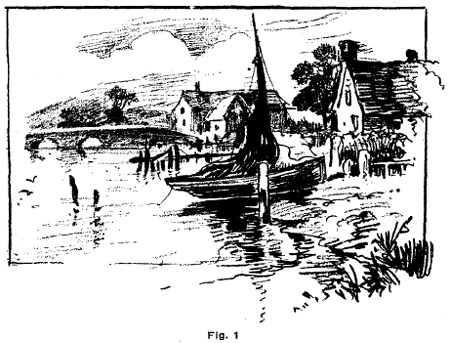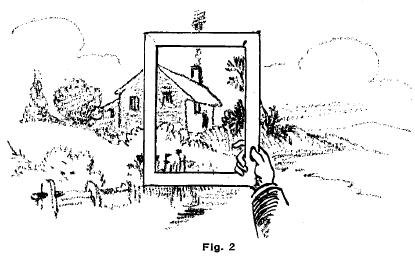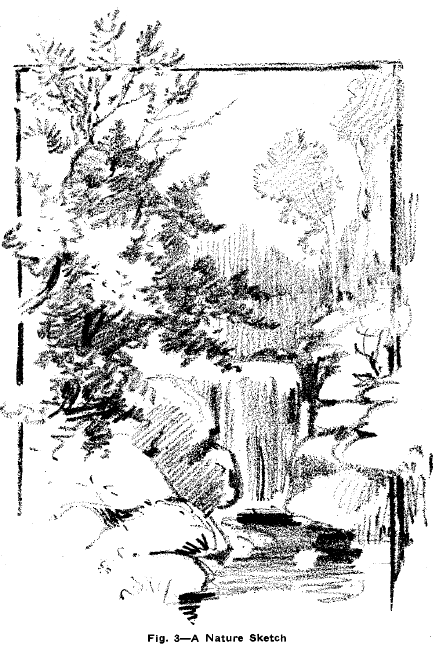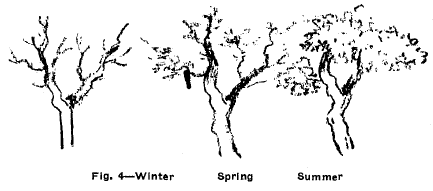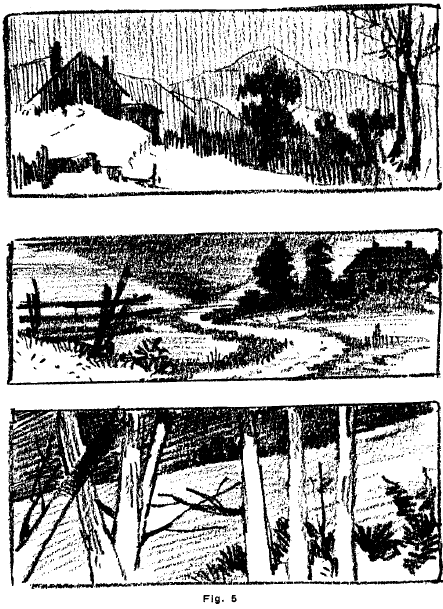Home > Directory Home > Drawing Lessons > Nature Drawing > How to Draw Nature & Landscapes
HOW TO DRAW NATURE WITH EASY TECHNIQUES DRAWING LESSON : How to Draw Nature and the Outdoors Tutorials
|
|
Drawing From NatureIn drawing from nature we should refrain from drawing that which is known to be present. Draw only that which is seen. Our vision should now be the guide, not our imagination. Distant Detail Appears Dim.Looking at a tree in the distance, we do not see the individual leaves on each bough. Or, if in town, in looking at a distant brick building we do not see each individual brick. But we know they are there. Nature provides that distant detail should appear dim to the human eye. Hence, such minor detail should not appear in the sketch. Knowing that they are there, there is a natural inclination to supply from memory the apparent deficiencies of the vision. Such inclinations should be resisted. The same principles apply to the detail in the foreground, for, even here, the moment the vision takes in the whole, multiplicity and detail are lost ; only the general masses being grasped by the eye. Therefore, no attempt should be made to put in many minute objects. Let all those parts of the picture that are accessory to the main objects have little more than the impression that will be given by a momentary view. The absence of detail is still more to be desired when considered from the standpoint of light and shade alone. The lights and darks of the trees in the immediate foreground contain much diversity of light and shade ; in the foliage of the middle distance, less will be noted ; while further away from the eye there is still less, and the objects there seem almost flat in their sameness. This is a phenomenon to be observed in all nature sketching, for details vanish as they recede from the eye. Tendency to Put in Detail because one's experience or memory tells that it is there, is so great that it is well to keep in mind always this axiom : The greater the distance of an object, the less detail is to be seen. Even the forms of objects become more and more indistinct as they recede from the eye. This is a law of atmospheric perspective. If this law be broken there will be disturbance, including encroachment and trespass, and these, as every one knows, are serious offenses ; for distance will encroach on the middle distance and the latter, in turn, will trespass on the immediate foreground. Distant objects should, if placed against the sky, be well relieved against the latter, but not harshly ; on the contrary, their outlines or outer tints may melt softly into the sky. When Finishing Is Unnecessary.In sketching from nature, avoid, as far as may be, any tendency to work over and over. Study the effects, as far as can be, in advance, and, as far as possible, make the drawing with single operations. Otherwise, distance and atmospheric perspective are lost and the effect is one of flatness devoid, of air and expression. In sketching from nature it is by no means necessary to make a finished drawing, but it is quite needful to indicate the character of the masses in outline and tone sufficiently to guide one in the more finished drawing or colored sketch to be made afterward. In sketching from nature one should strive not merely to make a pretty picture but to make lines and tones that will, to an extent, approximate those seen in nature, the model. In a composition to be made later, one may arrange the component parts of the picture to suit the individual taste. Cloud Forms.Give much attention to cloud forms. With rare exceptions, outlines should be defined, but not harshly. To take out the high lights in a pencil sketch use the sharp corners of the rubber eraser or use the paper masks as described in the chapter on Pastel-Stencils. One may use the "stump" in the main tones of the clouds or similar objects. Sharply defined objects projecting against the sky should be put in last. The lines in the distance may be partially obscured, but the sharply defined outlines in the foreground and middle distance should not be smudged or obliterated by the "stump" or anything else. In shading a landscape, a clear sky may be represented by drawing horizontal lines so that they will join or blend together, but the joining should not be perceptible. Masses of foliage may be shaded in a similar manner, except that the strokes forming them are less elongated and the pencil may have a more blunt point. Curved Lines for Clouds.In shading clouds, slightly curved, parallel lines may be used to advantage, and, where deeper accents of the shadows are to be indicated, these curved lines. may be crossed by a second series of parallel lines. While there is no set rule or rules relating to, the direction of tone or shade lines, a very good line of practice is to shade an entire drawing with nearly all lines running in the same direction. (See Fig. 5.)
Lines that Indicate Distance.In drawings made with closely drawn lines, parallel or otherwise—to convey the impression of tints or tones—the following may be considered as almost a rule, namely ; the greater the distance of the object, the lighter the lines that represent it. Reversely, the nearer the object the heavier the lines by which it is represented. As an example, Fig. 1 represents the rule. The clouds, being considered the most distant, were drawn with light lines—much lighter than they appear in the printed reproduction. The mountains, being somewhat less distant, were drawn with slightly less weakness of line. The bridge, the trees just beyond, and the houses all in the middle distance, were lined with more broad lines than in the cloud or mountain. Nearer, in the approaching foreground, the tree and house at the left, the lines are seen to be coarser still and aid in giving a sense of nearness. The detail of the sailboat, even its reflection, everything, in fact, in the immediate foreground was drawn with strong, vigorous treatment. Fig, 1 is an example that is a little more ambitious in its character than those preceding it, and may tax the ability of those who have not made considerable progress. The central point of interest is the sailboat, which has been treated with considerable strength in the way of intensely black lines, which are supplemented by the dark reflections in the water. The background is treated in light, close lines that contrast purposely with the freedom and boldness of the lines in the foreground. View Finder for Nature Drawing.Cut out the center from an oblong of cardboard as shown in Fig. 2. Hold it either vertically or horizontally as a picture frame at arm's length and select what to draw by moving the frame from side to• side or up and down. Then draw what appears within.
In drawing both figures and trees, it is well to begin with the simplest forms; the figures without the adornment of clothes or even flesh, the trees without foliage.
Contrast and Values"Value" as understood in the terms of art expresses the comparative relations of tones to each other, whether of shade or color. In making a drawing of a landscape, we would look at the tone of the trees against the sky and observe which is darker. If the sky be heavy and stormy and the light comes from behind the spectator, the trees may seem light by comparison, while the sky is darker in value. On the contrary, under ordinary circumstances, trees with dark, rich foliage would stand out in strong relief against the sky, the latter being this time lighter in value than the trees. The Keynote of a Picture.Similarly, we compare the rocks with the water, the fence to the road, the bough of the tree with the foliage, and so on, according to the different objects that come within the draftsman's vision. In the production of a drawing containing light and shade as it appears to the eye, in order to obtain the best results, it is necessary to establish at once the darkest value in the whole. This, the deepest spot of shadow in the picture, becomes the keynote with which all other tones of light or dark may be compared. Only by studying and observing the comparative variety of tones do we arrive at correct values. As an important quality in art, this cannot be overestimated, for the quality of a picture is apt to depend on a just appreciation of the values that it contains. Exercises in Single Line Direction.The exercises in Fig. 5 require careful attention. They are adaptable for any medium except the brush. Their significance lies in the fact that the principal lines in each scene are made with strokes in the same general direction. This does not apply, of course, to the details. In the upper sketch, the prevailing lines are vertical ; in the middle scene, the lines are horizontal, while in the botton scene, most of the lines are oblique.
|
Privacy Policy ..... Contact Us





